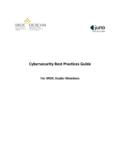Transcription of IA2 Assurance Information Associates, Inc.
1 1 Copyright 2004 IIAA22 Information Assurance Associates, Inc. Information System Security Manager (ISSM)/ Information Assurance Manager (IAM) Training (Satisfying CNSS 4012 standards) ISSM/IAM Course Overview: Information Assurance Associates (IA2) provides comprehensive certification training for Information System Security Managers (ISSMs) and Information Assurance Managers (IAMs) that is compliant with knowledge factors required by the Committee on National Security Systems (CNSS), which operates under the National Security Agency (NSA). The course curriculum was specifically designed for ISSMs and IAMs that exercise security control over Department of Defense (DOD), Combatant Command, Service or Agency (CC/S/A) and federal critical Information infrastructures.
2 The ISSM/IAM course provides one week of intense, highly concentrated, non-technical professional training necessary to achieve the fundamental knowledge, skills, and abilities needed to define, design, integrate, and manage Information system security policies, processes, practices, and procedures within DoD, CC/S/A, and federally controlled Information systems and networks. This course addresses knowledge factors and functional requirements established for Level I and Level II Technical and Management Information Assurance (IA) Workforce training. Specific focus is directed on identifying, implementing and integrating management and administrative solutions for securing critical Information infrastructures and establishing standards necessary to help protect the confidentiality, maintain the integrity and ensure the availability of sensitive data and critical organizational computing resources.
3 The IA2 ISSM/IAM course provides comprehensive training in establishing organizational Information System Security (ISS) policies, developing internal ISS processes, outlining critical ISS procedures, and implementing specially tailored ISS protocols. The focus of this course is to ensure effective security management of DOD, CC/S/A, and federal Information infrastructures that process sensitive, classified or national intelligence data. 2 Copyright 2004 Instructor Qualifications: The IA2 award winning instructor staff are all Certified Information System Security Professionals (CISSPs), Certified Information Security Managers (CISMs), Certified in NSA Information System Security Assessment and Evaluation Methodologies (IAM/IEM), and Master Training Specialists.
4 Additionally, each instructor has a minimum of fifteen years experience as a functional DOD, national Intelligence Community (IC) or federal Information System Security Manager. For IC applications, IA2 instructor staff members have been certified as NSA Adjunct Faculty and as NSA Accreditation Action Officers (AAOs) and hold a security clearance for access to SI/SCI data. References: Director Central Intelligence Directive (DCID) 6/3 Protecting Sensitive Compartmented Information Within Information Systems. DoD Directive , Information Assurance October 24, 2002.
5 DoD Instruction , Information Assurance Implementation, February 6, 2003 Joint DODIIS Cryptologic SCI Information System Security Standards (JDCSISSS) Rev 3, June 2003 DoD Directive (Draft), DoD IA Training, Certification and Workforce Management. December 17, 2003 DoD Directive , DoD Information Technology Security Certification and Accreditation Process (DITSCAP) Manual, July 2000. DoDD Data Sharing in a Net-Centric DoD, 2 December 2004 DODI DOD Information Technology Security Certification and Accreditation Process (DITSCAP), December 30, 1997.
6 DoD Personnel Security Program, January 1987 CJCSI Defensive Implementation Operations Aug 1997 CJCSM Defense-in-Depth: Information Assurance and Computer Network Defense (CND) December 2002 Public Law 100-235 Computer Security Act of 1987 OMB Circular A130 FIPS 4012/4014 CNSS No. 4009 Various Combatant Command, Service and Agency Directives 3 Copyright 2004 ISSM/IAM Course Content Information System Security Functions and Management Responsibilities. This lesson focuses on the security management and administration of Information systems processing sensitive, classified and cryptologic Information .
7 This lesson outlines individual roles, responsibilities, obligations, and liabilities. Special emphasis is placed in the following areas: The unique responsibilities and special obligations associated with Information System Security (ISS) management; The concept of centralized authority to facilitate daily Information system controls and decentralized management to ensure a high state of organizational Information security awareness, sensitivity and readiness. The need to establish an Information System Security Awareness Training and Education (SATE) program by; Defining training methodologies and establishing training requirements; Defining the process to develop terminal and enabling objectives, establish organizational training program focus and promote individual program goals; Discussing the Instructional Systems Design program standards for curriculum development as well as establishing education, evaluation and remediation goals.
8 The need to ensure and preserve individual privacy issues and concerns including; Individual expectation of privacy; Liability issues and concerns. A review of organizational obligations including the concept of due- care, best business/security practice, and reasonable and customary. Information Assurance Program Implementation. This lesson focuses on the unique security concerns associated with today s multi-protocol, multi-topology, multi-platform, fully distributed computing environments. Discussions center on: 4 Copyright 2004 Establishing an Information Assurance policy , creating a positive ISS climate, defining and establishing ISS goals, controlling and securing network interoperability and system interdependencies; Defining the Information Assurance Technical Framework (IATF) and Information Assurance Program elements and requirements.
9 Evaluating protection requirements and determining Information Mission Assurance Categories (MAC), Security Levels of Concern (LOC) and robustness Understanding the unique challenges and security requirements for sharing operationally critical data and protecting essential Information infrastructures in a Network-Centric environment; Defining and establishing Information Assurance Protection Measures including; Integrating appropriate administrative controls; Establishing internal Information Assurance policies, standards, baselines and guidelines; Defining personnel, physical, biometric and technical controls; Integrating software, firmware, COMSEC and TEMPEST controls.
10 Threat and Vulnerability Identification; Risk Analysis, Response and Recovery. This lesson focuses on the identification, analysis, assessment and evaluation of individual threats and vulnerabilities and their impact on an organization s critical Information infrastructures. Specific discussions focus on: The concept of threat analysis as well as the potential impact of common technical and non-technical (administrative) vulnerabilities and their corresponding relationship with identified threats; Countermeasure analysis that outlines ways to integrate reasonable, cost-effective controls necessary to mitigate the threat/vulnerability risk potential to an acceptable level; Risk assessment discussions that center on the resulting impact or harm to an organizations efficiency, functionality, reputation and mission.





